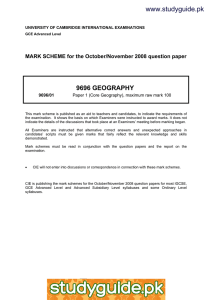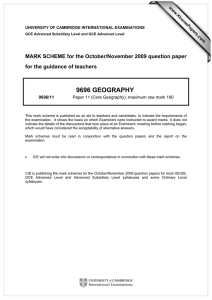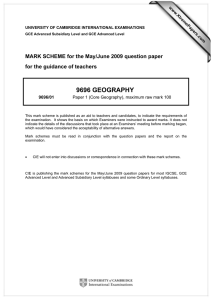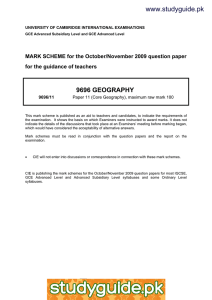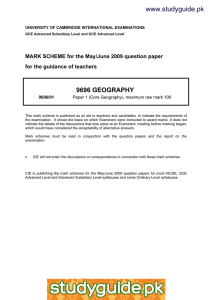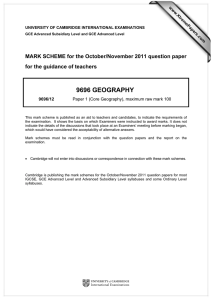9696 GEOGRAPHY MARK SCHEME for the October/November 2008 question paper
advertisement
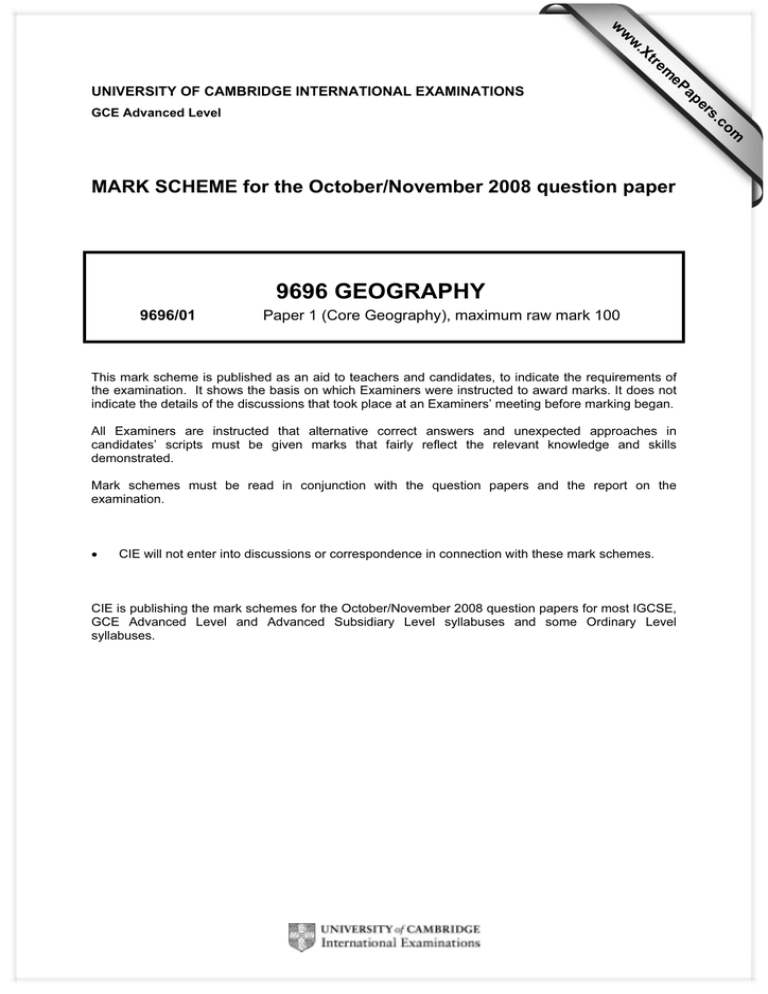
w w ap eP m e tr .X w UNIVERSITY OF CAMBRIDGE INTERNATIONAL EXAMINATIONS s er om .c GCE Advanced Level MARK SCHEME for the October/November 2008 question paper 9696 GEOGRAPHY 9696/01 Paper 1 (Core Geography), maximum raw mark 100 This mark scheme is published as an aid to teachers and candidates, to indicate the requirements of the examination. It shows the basis on which Examiners were instructed to award marks. It does not indicate the details of the discussions that took place at an Examiners’ meeting before marking began. All Examiners are instructed that alternative correct answers and unexpected approaches in candidates’ scripts must be given marks that fairly reflect the relevant knowledge and skills demonstrated. Mark schemes must be read in conjunction with the question papers and the report on the examination. • CIE will not enter into discussions or correspondence in connection with these mark schemes. CIE is publishing the mark schemes for the October/November 2008 question papers for most IGCSE, GCE Advanced Level and Advanced Subsidiary Level syllabuses and some Ordinary Level syllabuses. Page 2 Mark Scheme GCE A LEVEL – October/November 2008 Syllabus 9696 Paper 01 Section A Atmosphere and weather 1 Fig. 1 is a temperature height diagram showing unstable atmospheric conditions. (a) Give the rate of temperature decrease in degrees centigrade per 1000 metres for: (i) DALR (dry adiabatic lapse rate) [1] 10°C per 1000 metres (ii) SALR (saturated adiabatic lapse rate) [1] 12°C per 2000 metres, that is 6° per 1000 metres (b) Why are the rates of temperature decrease different for the DALR and the SALR? [3] The rate of cooling of the SALR is lower than that of the DALR due to the release of heat (latent heat) after condensation has occurred at condensation level in diagram. (c) Explain how the development of towering cumulus cloud shown on Fig.1. [5] Air at ground level will rise at the DALR (due to surface convection), such that it is warmer than the surrounding air allowing the parcel to cool at a slower rate than the ELR. Thus the air will continue to rise, expand and cool until condensation level is reached (1000m). At this point water vapour has reached 100% and condenses as droplets around hygroscopic nuclei. The air will continue to rise at the slower rate of the SALR and thus condensation will continue to form clouds of large vertical extent (towering Cu) until such time as the ELR and SALR are the same (i.e. at 3000m). This forms the top of the cloud development. [Total: 10] Rocks and weathering 2 Fig. 2 shows the distribution and movement of major crustal plates. (a) With reference to two of the plates named in Fig. 3, identify the type of plate boundary between them. [2] Divergent (constructive) boundaries should be given with appropriate plate pairings (e.g. S. American and African). Convergent (destructive) boundaries with appropriate plates (e.g. Nazca and S. America). Transform – N. American and Pacific. Any one pair of plate boundaries. (b) Describe the general distribution of the type of plate boundary you have named in (a). [2] Divergent are located mid ocean (mid Atlantic), convergent are along continental edges (Pacific Ring of Fire), Transform along the west coast N. America. Any one. © UCLES 2008 Page 3 Mark Scheme GCE A LEVEL – October/November 2008 Syllabus 9696 Paper 01 (c) Using diagrams, describe and explain the formation of two landforms associated with one of the types of plate boundary found on Fig. 3. [6] Divergent margins should produce diagrams illustrating the upwelling of magma along a mid ocean ridge, which can be associated with volcanoes, magnetic striping and sea floor spreading. Convergent should show subduction and the production of ocean trenches, fold mountains and island arcs. Transform are more difficult, but should show plate movement and volcanicity and the landform effects of earthquakes. Only two landforms required for chosen plate boundary. [Total: 10] Population change 3 Fig. 3 shows, for the year 2000, total fertility rates by country and their long-term impacts. (a) Name the continent where the population was growing the most rapidly in 2000. [1] Africa (no evidence needed for the mark). (b) Describe the distribution of countries for which a total fertility rate of 2.4–2.9 is shown in Fig. 3. [3] Quite widespread globally; found in three continents: mainly in the Americas, and Asia (only one country in Europe); global North and South; mixed MEDCs, NICs and LEDCs. It is not required to name individual countries, but credit can be given when they are used to describe the general distribution. (c) Suggest reasons why many countries experienced a total fertility rate below the replacement level (less than 2.3). [6] These are Stage 4 (fluctuating low BR and low DR) or Stage 5 (low DR > low BR) countries in terms of the demographic transition model. The DTM, whilst useful as an identifier, is however a description and not itself an explanation. The reasons may include: - age structure - societal norms on family size - aspirations and lifestyle preferences - costs of raising children - the position of women in society and economy - parental choice - singleness - higher average age at marriage - contraception, abortion and sterilisation - decrease in natural fertility e.g. through environmental factors - government policy (observe China on the figure) - other. Comprehensive answers are not needed for the modest mark allocation but suggest that reasons should be both social and economic. Credit overall quality, rewarding any specific examples or data offered. [Total: 10] © UCLES 2008 Page 4 Mark Scheme GCE A LEVEL – October/November 2008 Syllabus 9696 Paper 01 Population change/Settlement dynamics 4 Table 1 gives the results of a survey conducted in Jinan city, China, about the main problem experienced by workers who had migrated from rural areas. (a) Compare the two greatest percentage responses from male migrants and from female migrants. [3] both had affordability/high costs top (M 34.9%, F 37.1%) differ on second: M hard life, 26.9% but F loneliness 32.4% 1 2 For a response without data support max. 1 3 (b) Give two reasons why reliable information about the problems migrants experience may be difficult to obtain in a survey. [2] Any two reasons acceptable, may be drawn from the broad areas of survey design, survey conduct and the nature of response e.g. issues of respondents’ understanding, truthfulness, fear etc. Credit each reason 1. 2 (c) How may the discrimination which many rural migrants experience in cities be explained? [5] The discrimination may be on the basis of ethnicity, tribe, language, religion, socio-economic status, politics, gender or other. An explanation may focus on the social and economic chasm experienced; the real differences between urban and rural life; the domination or urban structures by powerful groups e.g. employers, landlords, local leaders, corrupt officials and the generally lowly status of migrants in terms of literacy, skills and financial situation. Some may be refugees or outcasts. Better candidates may bring in ideas of invasion and succession and existing groups or individuals trying to protect their hard-won jobs, space and rights. Credit the use of examples and a sense of rural-urban migration reality. [Total: 10] © UCLES 2008 Page 5 Mark Scheme GCE A LEVEL – October/November 2008 Syllabus 9696 Paper 01 Settlement dynamics 5 Figs 4A, 4B and 4C show the population age/sex pyramids for three districts of the city of San Diego, USA. (a) Giving evidence from the figures, name the district of San Diego which was likely to be: (i) the location of the state university; Montezuma 1 disproportionate 18–29 age group (approx. 48%) 1 (ii) a residential suburb favoured by families. [4] Coronado 1 large groups of parents and children 30–44 and under 17, balanced 1 (b) Explain briefly the economic factors which help to create residential districts of different characteristics within many large urban areas. [6] Responses are likely to centre around bid-rent and competition for space. Many candidates may see little more than personal or household income and ability to pay as the basis of residential station through the operation of the housing market. Candidates may include investment by local authorities in public sector housing or in infrastructure, e.g. transport networks which may then affect an area’s desirability if access is good and commuting possible. Urban renewal may be valid if the emphasis is residential. The syllabus includes special cases of squatter settlement in LEDCs and the inner city in MEDCs, either of which may be included legitimately, if treated in an economic manner. Credit the suitable use of examples and the clear identification of factors. [Total: 10] © UCLES 2008 Page 6 Mark Scheme GCE A LEVEL – October/November 2008 Syllabus 9696 Paper 01 Section B: The Physical Core Hydrology and fluvial geomorphology 6 (a) (i) Define the terms saltation and suspension in a river as they apply to the transportation of channel load. [4] Saltation is the bouncing of small particles of sediment along the stream bed. Suspension is the transportation of very light load by the current above the stream bed. The particles are the finest that can be supported by the current. (ii) Describe turbulent flow within a river channel. [3] Turbulent flow is the type of flow that occurs in a series of eddies in the current usually induced by channel roughness. (b) Using diagrams, describe the formation of: (i) a delta; Deltas are deposited where a slowing of river velocity causes a decrease in competence such that sediment is deposited. This can occur where velocity is reduced when a river enters a lake or the sea. It is not necessary to give the full range of delta types. (ii) floodplains and levees. [8] Floodplains are that part of the catchment that water floods into when overbankfull conditions occur. They are usually located in the lower parts of the river valley profile and are characterised by low relief and gentle gradients and are edged by bluffs. A levee is an elevated bank flanking the channel produced by the slowing of the river once the channel has been exceeded. (c) To what extent is it possible to predict and prevent the flooding of rivers? [10] Flood prediction can be achieved by, either analysing frequency of past events (incidence of 10, 50, 100 year events), or by catchment modelling. Both have severe limitations as predictive tools. Prevention can be attempted through dams (Nile, Colorado, Yangtze etc) which are effective at controlling flows but may have problems with volume downstream and sedimentation upstream. Other hard engineering solutions include levees, wing dykes and channel straightening. These have had limited success and in some cases (Mississippi) have increased effects of flooding. Good answer will show some appreciation of prediction methods and include some evaluation of flood control mechanisms Weaker answers will regard prediction as weather forecasting and will give descriptions of some flood control measures with little evaluation as to their effectiveness. Candidates will probably: L3 be able to describe the basic calculation of recurrence intervals and their use and limitations in flood prediction. Alternatively, they might describe catchment modelling. Flood prevention is difficult to achieve and is probably most effective when discharge is controlled through dams etc. [8–10] © UCLES 2008 Page 7 Mark Scheme GCE A LEVEL – October/November 2008 Syllabus 9696 Paper 01 L2 show an awareness of some methods of prediction (recurrence, modelling etc) but lacking detail of the methodology or of its effectiveness. A range of hard engineering to river channels but very limited appreciation of their relative effectiveness. [5–7] L1 confuse flood prediction with such things as catchment conditions and give a very limited account of some flood restriction methods (e.g. wing dykes). No real appreciation of flood prevention. [0–4] [Total: 25] Atmosphere and weather 7 (a) (i) What is meant by the term urban heat island? [4] The area (island) of relatively higher temperatures that are found in urban areas as compared with surrounding rural areas. Produced mainly by the capacity for buildings to retain heat and re-radiate it at night. (ii) Briefly describe one effect that atmospheric pollution may have upon urban climates. [3] Increases in smogs and photo-chemical smogs and fogs through particulate matter acting as hygroscopic nuclei and car exhausts in the atmosphere close to the surface. Reduction in solar radiation due to particulate matter over urban areas at higher altitudes. Increase in cloudiness and hence rainfall due to increase in hygroscopic nuclei. Any one of these. (b) With the use of diagrams, explain how the earth’s atmosphere is heated by solar radiation. [8] Essentially a diagram showing the six factor ‘day model’. Incoming solar radiation, reflected SR, energy absorbed by the surface, sensible heat transfer, long wave terrestrial radiation, latent heat transfer and absorption of heat through greenhouse effect etc. (c) Explain how winds can influence the distribution of global temperatures. [10] The earth receives more solar radiation in equatorial and tropical areas than at the poles, requiring the heat to be transferred latitudinally around the globe. Winds and ocean current are the means of achieving this. Where solar radiation is at its highest surface warming induces uplift and the air is moved in cell like movements in the atmosphere. The Hadley cell can be briefly explained. Much can be achieved with simple diagrams. Candidates will probably: L3 show an awareness of how the tri-cellular model is driven by solar radiation and how it transfers heat excess to areas of deficit. Some awareness of how winds occur, but a concentration on global temperature distribution. [8–10] L2 use the Hadley cell to illustrate the impact of wind on temperature redistribution. Some confusion between local and global, so may introduce land –sea breezes etc. [5–7] L1 show a vague notion of the distribution of winds (e.g. Trades, westerlies etc.) but little appreciation of either their generation or role in influencing temperature. Confusion of local and global. [0–4] [Total: 25] © UCLES 2008 Page 8 Mark Scheme GCE A LEVEL – October/November 2008 Syllabus 9696 Paper 01 Rocks and weathering 8 (a) (i) Define the terms heave and slide as they apply to mass movements. [4] Heave is the movement of (usually) surface particles by expansion and contraction in response to changes in temperature, moisture or freezing. Slide is movement on a sliding surface such as bedding planes or other discontinuities. (ii) Briefly describe an example of a mass movement resulting from the process of flow. [3] Flows are relatively rapid with high moisture content. They can take the form of debris flows (mixtures of fine and coarse debris), Earth or mud flow with high moisture content and rapid when liquefication occurs or solifluction (saturation of soil produced by seasonal melting). Any one example. (b) With the use of diagrams, describe how rock type and structure can affect the form of slopes. [8] Rock type is the primary control of slope steepness because the angle will depend upon shear strength. Thus hard rocks (granite) will support steeper slopes than weak cemented sandstones. Failure planes and discontinuities can lower slopes even in hard rocks. The dip of rocks influences slopes i.e. where dip is inwards towards the slope it tends to be stable, whilst if the dip is downslope rock slides can occur. (c) Describe the physical properties of granite rock and explain how granite can be weathered. [10] Granite is an igneous rock formed from magma. It is coarsely crystalline composed of quartz, feldspars and mica. There are many different kinds of granite, depending on rates of cooling etc. They are often characterised by marked jointing patterns and are prone to sheet jointing due to dilatation. Whilst being a hard and durable rock, it can be attacked by most weathering forms given the right climatic conditions. They are most prone to deep chemical weathering in humid tropical environments, where acidulated water and organic acids penetrate through joints and cracks to form a basal weathering surface. Hydrolysis is the most common process in these instances. In temperate areas exposed granite is subject to frost weathering and other forms of mechanical weathering again because of its jointed nature. Candidates will probably: L3 show a good appreciation of the physical and chemical composition of granite and be able to explain how these properties influence its weathering with some exemplification. [8–10] L2 show a limited appreciation of the nature of granite but some awareness of its joints and mineral composition that makes it vulnerable to both chemical and some mechanical processes. May dwell upon deep chemical weathering without really associating it with the nature of granite. [5–7] L1 show little appreciation of granite beyond it being a hard rock. Any weathering processes (e.g. freeze–thaw) will be described with little reference to granite. [0–4] [Total: 25] © UCLES 2008 Page 9 Mark Scheme GCE A LEVEL – October/November 2008 Syllabus 9696 Paper 01 Section C: The Human Core 9 (a) (i) Give the meaning of the term death rate. [2] (crude) DR is the number of deaths or people who die 0, per 1000 or % 1, a year or per annum 1 (ii) Explain three factors which help to account for the low death rates in MEDCs. [5] Any three acceptable but they need to be different, may include: social e.g. education, better diets; economic e.g. investment in healthcare systems, income levels; environmental e.g. safe water supply, housing quality; and political e.g. government campaigns. Credit specificity and not simply ‘the best of everything’. Credit factors 1 or 2. (b) With the help of a diagram, describe the changes in the death rate shown by the demographic transition model. [8] A good, annotated diagram of the DTM may do well. Candidates only need to show Stages 1–4 but may include a Stage 5, where low DR>low BR. The key elements to describe are high fluctuating DR in Stage 1, a drop in DR heralding the onset of Stage 2, steady decline through Stages 2 and 3 and low fluctuation in Stage 4. If candidates attempt rates accept something of the order of 40 per 1000 at highest and less than10 per 1000 at lowest. Many candidates may do so, but there is no need for explanation and there are no marks available. (c) Forecasts in the 1950s of what India’s total population would be in 2001 varied from 790 to 1146 million. The 2001 census recorded 1027 million people. Why is it so difficult to make accurate population forecasts? [10] There are several broad areas of difficulty including likely changes in BR, DR and hence NIR; the collection and processing of data; the validity of the statistical models used and unforeseen circumstances. Of these, candidates are perhaps likely to focus on vital rates and unforeseen events (especially catastrophes?) Candidates will probably: L3 develop a high quality explanation, demonstrate a sense of judgment, build-up a number of reasons based on good conceptual understanding and the use of examples. [8–10] L2 produce a sound response which may be good in parts but which lacks overall perspective or much exemplar content. Show satisfactory knowledge but not address ‘Why?’ particularly clearly. [5–7] L1 make one or more basic points. At the top of the level offer a general response, perhaps based on one area of difficulty. Notes and fragments remain in this level. [0–4] [Total: 25] © UCLES 2008 Page 10 Mark Scheme GCE A LEVEL – October/November 2008 Syllabus 9696 Paper 01 Population change 10 (a) (i) Give the meaning of the term international migration. [3] the movement of people or population 1 across national borders/between countries 1 for a duration of at least one year (the discriminator) 1 (ii) With the help of examples, outline two types of voluntary international migration.[4] Circulation, such as tourism and business trips, should be excluded but any two types are acceptable e.g. economic migrants, those who emigrate such as on retirement or business moves, diplomats etc. 4 (b) Describe and explain the factors which may influence how likely a person is to migrate internationally. [8] May distinguish between voluntary and involuntary (forced) moves but there is no need to do so. Despite the word factors there is more to this than push/pull. Classically voluntary migration is influenced by age (younger), gender (more males) and distance (exhibiting a distance decay). Other factors include: - conditions in source area (social, economic, environmental, political) perception of and information about destinations ability to meet associated costs e.g. of travel family and friends e.g. encouragement individual character e.g. risk-taking government restrictions e.g. visas and work permits other 8 (c) To what extent do you agree that international migration has a negative economic impact on source areas? [10] Candidates may balance concepts such as the brain drain and brawn drain against remittances, return migration of the successful and the release of pressure in overpopulated areas. Candidates will probably: L3 develop an effective assessment of both the positive and the negative, convince by argument, reality and the use of examples. [8–10] L2 provide an answer that goes part way to dealing with the question but which remains limited in detailed knowledge, understanding and/or in the assessment made. [5–7] L1 make a basic response which may stray from the question set. May offer an opinion but not support it by argument or example. Lack the skills, understanding or time to offer more than a few points or sweeping statements. [0–4] [Total: 25] © UCLES 2008 Page 11 Mark Scheme GCE A LEVEL – October/November 2008 Syllabus 9696 Paper 01 Settlement dynamics 11 (a) (i) Explain the meaning of the term urbanisation. [2] urbanisation is the process by which the proportion of people living in towns and cities (urban areas) increases, or the process of concentration of population into urban areas. It involves, but should be distinguished from, rural-urban migration. 2 (ii) Give two reasons why rates of urban growth are low in many MEDCs. [5] Any two valid reasons acceptable e.g. stage of urbanisation cycle or counterurbanisation, growing negatives of urban residence, perceived positives of rural residence etc. May include population dynamic of DTM Stages 4 or 5. For a simple point 1 and for a developed point 2 or 3 to maximum [5] (b) With the help of one or more examples, describe the effects of rural-urban migration on rural areas of LEDCs. [8] Most are likely to see this largely negatively, in any dimension: social, e.g. break up of families by rural-urban migration; economic, e.g. as population threshold falls and services close; and environmental, e.g. as holdings are abandoned or urban area extends into rural fringe. Better accounts may be more balanced and see positives: social, e.g. reduction of population pressure; economic, e.g. remittances or the return of entrepreneurs; political, e.g. rural areas gaining a voice or representation. For a general account or an example in name only, max. 5. 8 (c) Assess the effectiveness of strategies for reducing urbanisation in LEDCs, giving reasons for their success or failure. [10] Two broad types of strategy exist: measures improving rural areas and measures seeking to make urban areas less attractive, e.g. through the media or through attempts to control internal migration. The former are more likely to be seen and could provide a full answer. It may be pointed out by the astute that strategies may succeed in slowing rural-urban migration without affecting the overall percentage urbanised etc. Candidates will probably: L3 make a clear assessment of effectiveness based on detailed knowledge of examples of strategies. Develop good reasoning in relation to the strategies’ success/failure, organise the answer well. [8–10] L2 show some knowledge of strategies and outcomes but provide a response which is limited in reasoning, detail or assessment. [5–7] L1 provide a basic response which may introduce one or more strategies with little or no assessment or much reasoning. Notes and fragments remain in this level. [0–4] [Total: 25] © UCLES 2008

